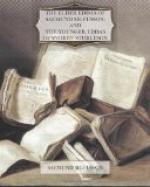FOOTNOTES:
[Footnote 125: This chapter is probably the interpolation of an early copyist, for it has evidently no connection with the following one, and is not found in the Upsal MS. of the Prose Edda, which is supposed to be the oldest extant. Gefjon’s ploughing is obviously a mythic way of accounting for some convulsions of nature, perhaps the convulsion that produced the Sound, and thus effected a junction between the Baltic and the Northern Ocean.]
[Footnote 126: Rime Giants, or Giants of the Frost.]
[Footnote 127: Literally, “It is light and hot, insomuch so that it is flaming and burning, and it is impervious to those who are outlandish (foreign), and not indigenous there” (or who have no home or heritage therein).]
[Footnote 128: More properly speaking, to the earth which it encircled.]
[Footnote 129: A ferreous or glacial refrigeration.]
[Footnote 130: i.e. If Thor drove over Bifrost with his thunder chariot.]
[Footnote 131: i.e. Present, Past, and Future.]
[Footnote 132: Namely, his having killed Baldur.]
[Footnote 133: Mind or Thought, and Memory.]
[Footnote 134: i.e. Devouring flame.]
[Footnote 135: i.e. Spirit or thought.]
[Footnote 136: i.e. Eld or Old Age.]
[Footnote 137: Finn Magnusen’s explanation of this myth is, that Iduna—the ever-renovating Spring—being in the possession of Thjassi—the desolating winter—all nature languishes until she is delivered from her captivity. On this being effected, her presence again diffuses joy and gladness, and all things revive; while her pursuer, Winter, with his icy breath, dissolves in the solar rays indicated by the fires lighted on the walls of Asgard.]
GLOSSARY.
AEGIR or OEGIR, horror, terror.
AESIR, sing. AS; God, Gods. ASYNJA, ASYNJOR; Goddess, Goddesses.




